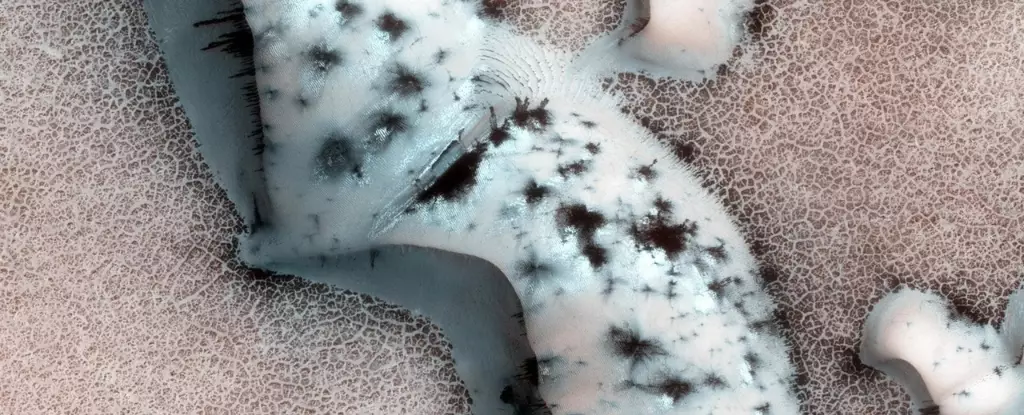Mars, the fourth planet from the Sun, often evokes a fascination that blends the allure of the unknown with a stark, desolate landscape. Unlike Earth’s lush environments and vibrant ecosystems, Mars presents a different kind of beauty—one that is haunting, isolated, and yet intrinsically captivating. In this exploration, we delve into the unique Martian phenomenon of carbon dioxide (CO2) geysers and the spectacular geological features that accompany them, investigating the eternal tension between the planets and the delicate systems at play.
The Martian Atmosphere and Its Implications
Mars is enveloped by a remarkably thin atmosphere, comprised predominantly of carbon dioxide, which constitutes about 95% of its gaseous envelope. This stark differentiation from Earth’s oxygen-rich air shapes not only the weather patterns but also the geological phenomena on the planet. The Martian winters are particularly striking, as the drop in temperatures leads to the freezing of CO2, resulting in a frosty layer that blanketed the poles for months. This seemingly lifeless expanse, however, experiences a transformation as spring descends upon Mars.
As the sun re-emerges from the dark embrace of winter, its rays penetrate this icy layer, gradually warming the surface beneath. The heat intervenes, causing the frozen CO2 to sublime; slowly, gas builds under the surface ice, creating pressure that eventually seeks escape. This subtle interaction of heat and pressure marks the birth of something remarkable: geysers of gas that burst through the icy façade, distributing dark material across the Martian surface in a spectacular display.
NASA’s Mars Reconnaissance Orbiter captures dramatic images of these extraterrestrial geysers, which have been evidenced to erupt with an impressive force, sometimes reaching speeds of 160 kilometers per hour. These eruptions can manifest into large spots, swirling material as vast as one kilometer wide—each event instigating changes that take the surface of Mars into a dance of beauty and chaos. The resulting features exhibit a fascinating resemblance to arachnids—clusters that mimic spider-like patterns are termed araneiform terrain, showcasing how the Martian landscape can, in its own right, evoke vivid imagery.
Astounding as these geysers are, the scientific community has further ventured to understand the underlying mechanisms that contribute to their formation. The groundbreaking work conducted by physicist Eric Keiffer and his colleagues presents a model—a framework that elucidates the cyclical nature of atmospheric CO2 and its geophysical consequences. According to their research, the nature of the seasonal CO2 ice caps lays the groundwork for this cycle, leading to the formation of high-pressure gas pockets that disrupt the icy veneer.
In contemplating these striking Martian features, one cannot escape the feeling of contrasting beauty when compared to Earth. While poets and artists have long cherished the diverse landscapes of our planet, Mars presents a different narrative—one filled with mystery and otherworldliness. Its remarkable geology diverges from the familiar imagery we associate with nature on Earth. The geological processes that result in the formation of CO2 geysers and araneiform terrains are not mirrored in our own atmospheric processes, rendering Mars a unique case study in planetary geology.
Scientific research continually illuminates this alien world, dispelling myths while revealing astonishing truths about how planetary systems interact differently across the solar system. While we may often romanticize Earth’s irreplaceable landscapes, they do not encompass the full spectrum of beauty that our galaxy offers. The CO2 geysers of Mars are a testament to that—an exotic reminder that life beyond our home planet may possess an unparalleled aesthetic that transcends commonplace perceptions.
In examining the geological marvels of Mars, we are reminded of the cosmos’ complexity and the unique traits of each celestial body. The CO2 geysers serve as portals to a magnificent world that reflects a beauty unlike anything found on Earth. Those who engage with Martian landscapes are offered a nuanced perspective on nature, revealing that there is artistry even in desolation. The continuous study and exploration of Mars not only quenches our thirst for knowledge but also inspires us to appreciate the remarkable diversity that our universe holds, where beauty manifests in forms we can hardly fathom.

